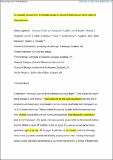A skeleton from the Middle Jurassic of Scotland illuminates an earlier origin of large pterosaurs
Abstract
Pterosaurs were the first vertebrates to evolve flight1,2 and include the largest flying animals in Earth history.3,4 While some of the last-surviving species were the size of airplanes, pterosaurs were long thought to be restricted to small body sizes (wingspans ca. <1.8–1.6 m) from their Triassic origins through the Jurassic, before increasing in size when derived long-skulled and short-tailed pterodactyloids lived alongside a diversity of birds in the Cretaceous.5 We report a new spectacularly preserved three-dimensional skeleton from the Middle Jurassic of Scotland, which we assign to a new genus and species: Dearc sgiathanach gen. et sp. nov. Its wingspan is estimated at >2.5 m, and bone histology shows it was a juvenile-subadult still actively growing when it died, making it the largest known Jurassic pterosaur represented by a well-preserved skeleton. A review of fragmentary specimens from the Middle Jurassic of England demonstrates that a diversity of pterosaurs was capable of reaching larger sizes at this time but have hitherto been concealed by a poor fossil record. Phylogenetic analysis places D. sgiathanach in a clade of basal long-tailed non-monofenestratan pterosaurs, in a subclade of larger-bodied species (Angustinaripterini) with elongate skulls convergent in some aspects with pterodactyloids.6 Far from a static prologue to the Cretaceous, the Middle Jurassic was a key interval in pterosaur evolution, in which some non-pterodactyloids diversified and experimented with larger sizes, concurrent with or perhaps earlier than the origin of birds.
Citation
Jagielska , N , O’Sullivan , M , Funston , G F , Butler , I B , Challands , T J , Clark , N D L , Fraser , N C , Penny , A , Ross , D A , Wilkinson , M & Brusatte , S L 2022 , ' A skeleton from the Middle Jurassic of Scotland illuminates an earlier origin of large pterosaurs ' , Current Biology , vol. 32 , no. 6 , pp. 1446-1453 . https://doi.org/10.1016/j.cub.2022.01.073
Publication
Current Biology
Status
Peer reviewed
ISSN
0960-9822Type
Journal article
Description
Funding: The authors thank the National Geographic Society (GEFNE185-16 to PI S.L.B.) for funding the fieldtrip on which the new pterosaur was found, a Philip Leverhulme Prize (to S.L.B.) for funding Edinburgh’s palaeontology laboratory, NERC for N.J.’s E4DTP studentship (NE/S007407/1), and the Royal Society (NIF\R1\191527 to G.F.F.) for funding the paleohistology workspace.Collections
Items in the St Andrews Research Repository are protected by copyright, with all rights reserved, unless otherwise indicated.

